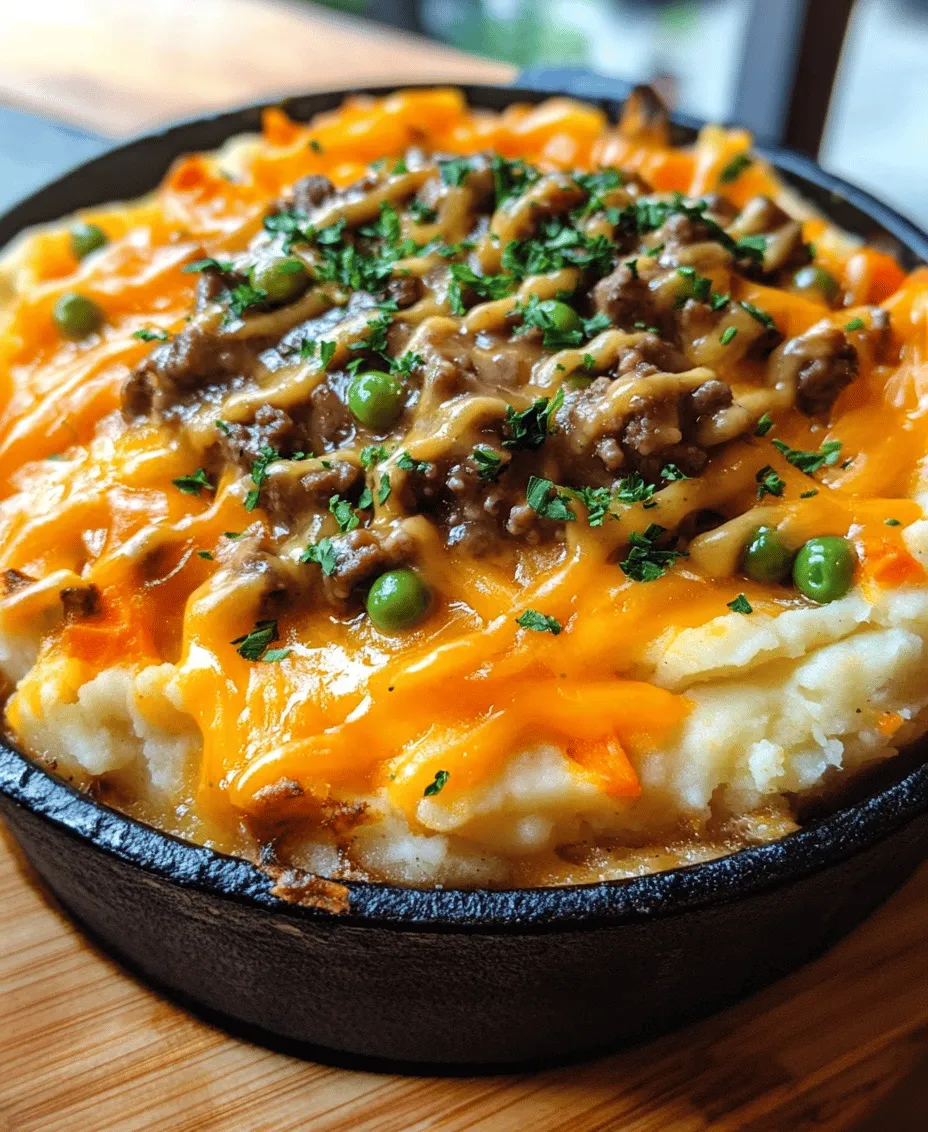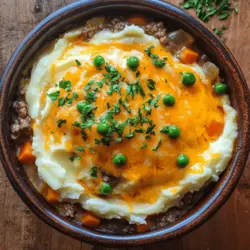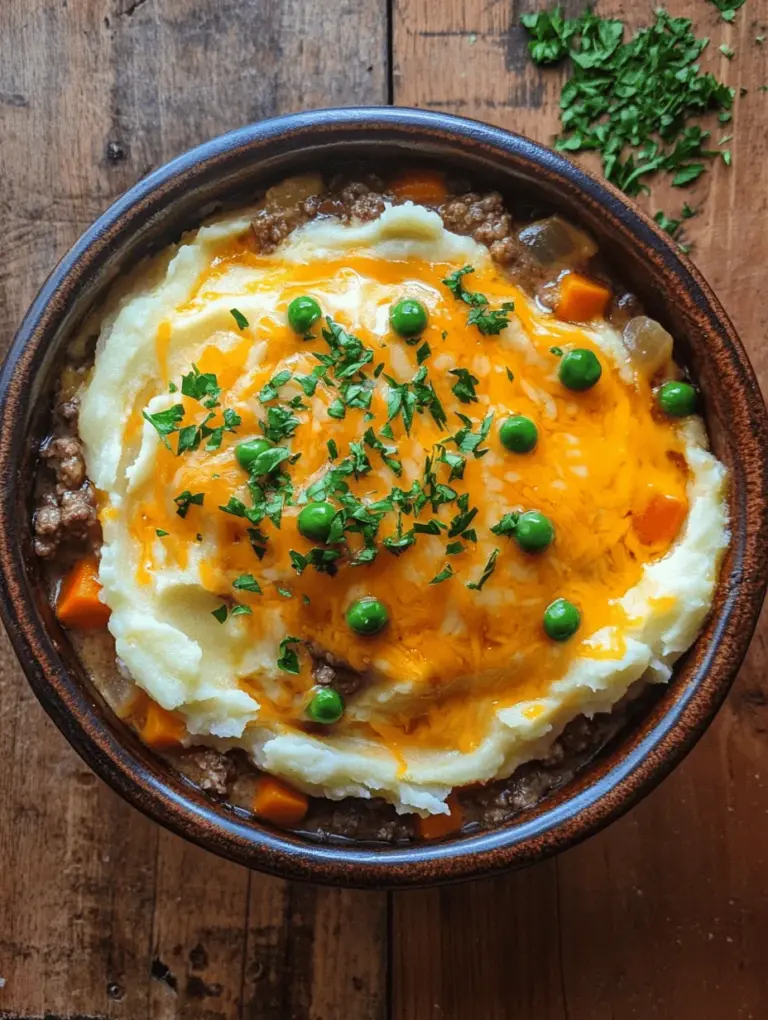Introduction to Poor Man’s Pie
In the realm of home-cooked meals, few dishes evoke the same sense of nostalgia and comfort as Poor Man’s Pie. This hearty, satisfying dish has been a staple in many households for generations, reflecting the spirit of frugality and creativity in the kitchen. Poor Man’s Pie, also known as Shepherd’s Pie or Cottage Pie depending on the meat used, is essentially a savory pie filled with flavorful ground meat and vegetables, all topped with a creamy layer of mashed potatoes. It’s a dish that not only fills the belly but also warms the heart, making it a beloved choice for families looking to enjoy a comforting meal without breaking the bank.
The origins of Poor Man’s Pie can be traced back to the 18th century, rooted in the agricultural practices of the working class in the United Kingdom. It was a dish born out of necessity, crafted to utilize leftovers and minimize waste. The basic premise of the pie is simple: use what you have on hand to create something delicious and fulfilling. Traditionally, it uses inexpensive ingredients, making it a go-to recipe for families seeking nourishment on a budget. This adaptability and reliance on readily available ingredients have allowed Poor Man’s Pie to transcend cultures and evolve into various interpretations around the world.
In its classic form, Poor Man’s Pie consists of a base made from ground meat, often mixed with sautéed vegetables, and finished with a creamy layer of mashed potatoes. Each ingredient plays a significant role in creating a harmonious balance of flavors and textures. The ground meat provides protein and heartiness, while the vegetables contribute freshness and nutrition. The mashed potato topping creates a comforting barrier, sealing in the savory filling and offering a delightful contrast in texture.
The Allure of Comfort Food
Comfort food is a term that evokes feelings of warmth, familiarity, and satisfaction. It encompasses dishes that remind us of home, family gatherings, and cherished memories. Psychologically, comfort food can serve as a source of solace during stressful times, providing a sense of security and emotional well-being. The act of cooking and sharing comfort food often brings people closer together, fostering connection and community.
Poor Man’s Pie embodies the essence of comfort food. Its rich, savory filling and creamy topping create a dish that is not only delicious but also satisfying and nurturing. The warm, hearty flavors evoke feelings of home-cooked goodness, making it an ideal meal for cold evenings or times when you need a little extra comfort. Moreover, the affordability and accessibility of the ingredients used in Poor Man’s Pie make it a practical choice for many households, allowing everyone to enjoy a comforting meal without overspending.
In a world where food can sometimes feel extravagant and expensive, Poor Man’s Pie stands out as a beacon of simplicity and practicality. It reminds us that delicious, nourishing meals can be made with humble ingredients, crafted with care to create something truly special.
Exploring the Ingredients
Ground Meat Choices
At the heart of Poor Man’s Pie lies the ground meat, which serves as the foundation of the dish. While traditional recipes often call for ground beef, there are several options to consider, including ground turkey, lamb, or even plant-based alternatives for those seeking a vegetarian option. Each choice brings its unique flavor and texture to the pie.
Using ground beef provides a rich, beefy flavor that pairs well with the savory filling. It’s a popular choice for its satisfying taste and availability. On the other hand, ground turkey offers a leaner alternative with less fat, making it a healthier option without sacrificing flavor. Nutritionally, turkey is lower in calories and saturated fat compared to beef, which may appeal to those watching their dietary intake.
When selecting ground meat for your Poor Man’s Pie, consider the flavor profile you desire. Ground beef will yield a more robust and hearty filling, while ground turkey will result in a lighter dish. The choice ultimately comes down to personal preference and dietary needs.
Vegetables as the Heart of the Dish
While the ground meat serves as the backbone of Poor Man’s Pie, the vegetables are essential for flavor, texture, and nutrition. Commonly used vegetables include onions, carrots, and peas, each adding its unique contribution to the dish. Onions provide a savory base, enhancing the overall depth of flavor. Carrots add a subtle sweetness and a pleasant crunch, while peas contribute a pop of color and freshness.
Incorporating vegetables into your Poor Man’s Pie not only boosts the nutritional value but also enhances the dish’s overall appeal. Vegetables are rich in vitamins, minerals, and fiber, making them an important component of a balanced meal. By including a variety of vegetables, you can create a more complex flavor profile and add texture to the filling.
Cream of Mushroom Soup: A Quick Flavor Booster
A key ingredient that elevates the filling of Poor Man’s Pie is cream of mushroom soup. This canned staple serves as a quick and easy way to add creaminess and depth of flavor to the dish. The earthy notes of mushrooms complement the meat and vegetables, creating a harmonious blend of tastes. If you’re looking for convenience, using canned soup can save time and effort in the kitchen.
However, for those who prefer a homemade touch, there are plenty of recipes available to create your own cream of mushroom soup from scratch. This allows you to control the ingredients and customize the flavors to suit your preferences. Whether you opt for the convenience of canned soup or take the time to make your own, this ingredient plays a crucial role in achieving a rich, creamy filling.
The Importance of Spices and Seasoning
To truly bring Poor Man’s Pie to life, spices and seasonings are essential. Garlic powder and Worcestershire sauce are two key players in enhancing the flavor of the dish. Garlic powder adds a warm, aromatic note that complements the savory elements, while Worcestershire sauce introduces a depth of umami flavor, tying all the ingredients together.
When it comes to seasoning your Poor Man’s Pie, it’s important to adjust the flavors to your taste. Start with the recommended amounts, and feel free to experiment with additional spices, such as black pepper, thyme, or rosemary, to personalize the dish. The right balance of seasoning will elevate your pie and make it even more satisfying.
The Mashed Potato Topping
No Poor Man’s Pie is complete without its signature topping: mashed potatoes. This creamy layer not only adds texture but also serves as a protective barrier, keeping the filling warm and moist. You have the option to use store-bought mashed potatoes for convenience or whip up a batch from scratch for a more homemade touch.
When making your own mashed potatoes, the texture and creaminess are key. Use a combination of butter and milk to achieve a smooth, velvety consistency. For added richness, consider mixing in sour cream or cream cheese. The topping should be spread generously over the filling, creating a comforting layer that melts in your mouth.
Cheese: The Finishing Touch
For many, the addition of cheese is what takes Poor Man’s Pie to the next level. Cheddar cheese is a classic choice, offering a sharp, tangy flavor that complements the savory pie perfectly. As the cheese melts during baking, it creates a delicious, golden crust that adds both flavor and visual appeal to the dish.
If you’re looking to switch things up, consider experimenting with alternative cheeses. Monterey Jack, Gruyère, or even a sprinkle of Parmesan can introduce different flavor notes and textures to your Poor Man’s Pie. The choice of cheese is entirely up to you, allowing for personalization and creativity in the kitchen.
Step-by-Step Preparation Guide
Prepping the Oven and Ingredients
Before diving into the preparation of your Poor Man’s Pie, it’s essential to set the stage for success. Start by preheating your oven to 400°F (200°C). Preheating the oven is crucial for ensuring even cooking and achieving that perfect golden crust on top of your pie.
While the oven heats up, take the time to prepare your ingredients. Chop the vegetables and measure out the spices and seasonings. If you’re using fresh potatoes for the topping, peel and cut them into chunks to speed up the cooking process. Efficient ingredient preparation not only saves time but also makes the cooking process more enjoyable.
With the oven prepped and the ingredients ready, you’re well on your way to creating a comforting, delicious Poor Man’s Pie that will surely become a beloved addition to your recipe repertoire. In the next section, we’ll delve into the detailed steps for assembling and baking this classic dish, ensuring that every bite is filled with flavor and warmth.

Cooking the Meat Mixture
To create a rich and flavorful Poor Man’s Pie, the first step is to cook the meat mixture properly. Start by heating a large skillet over medium heat. Add the ground meat of your choice; beef, turkey, or chicken work well.
Detailed Instructions on Browning the Meat and Draining Fat
As the meat begins to brown, use a wooden spoon to break it apart into smaller pieces. This helps ensure even cooking and allows for better texture. Browning the meat is crucial as it develops a depth of flavor through the Maillard reaction, which occurs when proteins and sugars in the meat react under heat.
Once the meat is fully browned, approximately 8 to 10 minutes, drain any excess fat from the skillet. This step is essential for preventing the pie from becoming greasy. If using lean meat, this may not be necessary, but if you’ve opted for a fattier cut, it’s best to drain well for a cleaner taste.
Importance of Achieving the Right Texture in the Meat
The texture of the meat in your Poor Man’s Pie is vital for a satisfying bite. Aim for a crumbly yet moist consistency. Overcooked meat can become tough and dry, while undercooked meat can be chewy. To achieve the right texture, monitor the cooking time carefully and avoid overcrowding the skillet, which can cause the meat to steam rather than brown.
Incorporating Vegetables
Once your meat is browned and drained, it’s time to add vegetables to enhance the filling’s flavor and nutrition.
Techniques for Cooking Vegetables to Enhance Their Flavor
Add chopped onions, carrots, and celery to the skillet. These aromatic vegetables not only contribute to the flavor base but also add sweetness and texture to the filling. Sauté the vegetables in the remaining fat for about 5 minutes or until they soften. This technique of cooking vegetables alongside the meat allows them to absorb the meaty flavors, creating a more unified taste.
Importance of Timing in the Cooking Process
Timing is crucial when incorporating vegetables. Adding them too early can lead to mushy textures, while adding them too late can prevent the flavors from melding. The goal is tender, flavorful vegetables that complement the meat, so aim to add them at the right moment for optimal results.
Combining the Filling
Now that you have a well-cooked meat and vegetable mixture, it’s time to bring everything together.
How to Achieve the Perfect Consistency in the Filling
To create a cohesive filling, sprinkle in flour (or cornstarch for a gluten-free option) while stirring. This will help thicken the mixture. Gradually add beef or chicken broth, stirring constantly to avoid lumps. The filling should be thick enough to hold its shape but still creamy. If it’s too thick, add a bit more broth; if it’s too thin, allow it to simmer a little longer until it reaches your desired consistency.
Tips for Ensuring Even Distribution of Flavors
For an even distribution of flavors, consider adding spices and herbs like thyme, rosemary, salt, and pepper. Taste the filling as you season to ensure it’s balanced and flavorful. Allow the mixture to simmer for a few minutes so that the flavors meld together beautifully.
Assembling the Pie
With your filling ready, it’s time to assemble your Poor Man’s Pie.
Instructions for Using Pie Crust Versus Biscuit Dough
You can choose between a traditional pie crust or using biscuit dough for a heartier texture. If you opt for a pie crust, roll it out to fit your pie dish, ensuring there are no cracks. If using biscuit dough, prepare it according to the package instructions or homemade recipe, and simply spread it over the filling.
Ensure that the edges are crimped or sealed properly to prevent any filling from bubbling out during baking.
Techniques for Spreading Mashed Potatoes Evenly
Next, prepare your mashed potatoes (made from boiled potatoes, milk, and butter). Spread a generous layer of mashed potatoes over the filling, starting from the middle and working your way to the edges. Use a spatula to smooth the potatoes evenly across the top. This not only provides a beautiful presentation but also ensures that every bite has that creamy potato goodness.
Baking the Pie
Now it’s time to bake the pie.
Importance of Monitoring Baking Time for Optimal Results
Preheat your oven to 375°F (190°C). Bake the pie for about 25 to 30 minutes, or until the mashed potatoes are golden and the filling is bubbling. Keep an eye on the pie as it bakes; if the potatoes brown too quickly, cover them with foil to prevent burning.
Tips for Achieving a Golden-Brown Top
For an even more appealing presentation, consider brushing the top of the mashed potatoes with a bit of melted butter or an egg wash before baking. This will help create a beautiful golden crust that is both visually appealing and delicious.
Serving Suggestions and Pairings
Once the Poor Man’s Pie is out of the oven, it’s time to serve up this comforting dish.
Ideal Accompaniments
Pair your Poor Man’s Pie with fresh side dishes to balance the meal. A simple green salad with a tangy vinaigrette complements the richness of the pie. Steamed green beans or glazed carrots can add a pop of color and provide a refreshing contrast.
Discussion on Beverage Pairings for a Complete Meal Experience
For beverages, consider serving a light-bodied red wine, like Pinot Noir, which pairs well with the savory flavors of the meat and vegetables. Alternatively, a crisp apple cider can enhance the meal’s comfort food vibe, making it a perfect accompaniment.
Presentation Ideas
Presentation is key when serving Poor Man’s Pie, especially for gatherings.
Creative Ways to Present the Pie for Family Meals or Gatherings
Consider serving the pie directly in the baking dish for a rustic look. Alternatively, you can slice individual portions and serve them on plates with a garnish of fresh parsley for a pop of color. This not only makes the dish more appealing but also adds a fresh flavor.
Enjoying Leftovers: Storage and Reheating Tips
One of the best aspects of Poor Man’s Pie is the delicious leftovers.
Best Practices for Storing Leftover Poor Man’s Pie
Store any leftover pie in an airtight container in the refrigerator for up to three days. If you have a larger portion, consider slicing it into individual servings for easier reheating.
Ideal Refrigeration and Freezing Techniques
For longer storage, Poor Man’s Pie freezes beautifully. Wrap portions tightly in plastic wrap and then in aluminum foil or place them in freezer-safe containers. It can last up to three months in the freezer.
Tips for Reheating to Maintain Flavor and Texture
To reheat, place the pie in a preheated oven set at 350°F (175°C) and heat until warmed through, approximately 20-30 minutes. If reheating individual slices, you can use the microwave, but be sure to cover the pie with a damp paper towel to keep it from drying out.
Creative Ways to Repurpose Leftovers
Leftovers can be transformed into exciting new meals.
Consider using leftover filling as a filling for stuffed peppers or tacos. You can also mix the filling with cooked pasta for a hearty casserole. The mashed potatoes can be used to top shepherd’s pie or added to a frittata for a breakfast option.
Conclusion: The Lasting Appeal of Poor Man’s Pie
Poor Man’s Pie is not just a dish; it’s a comforting tradition that has found its way into many homes. Its simple ingredients and hearty flavors make it a beloved choice for family dinners. This dish exemplifies the essence of comfort food—nourishing, satisfying, and perfect for bringing loved ones together around the table.
As you embark on your culinary journey to make Poor Man’s Pie, remember that cooking is not just about following a recipe but also about creating memories with those you cherish. Whether it’s a chilly evening or a family gathering, this pie is sure to deliver warmth and joy. So gather your ingredients, roll up your sleeves, and enjoy making this classic dish that will surely become a staple in your home.

